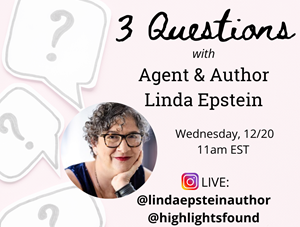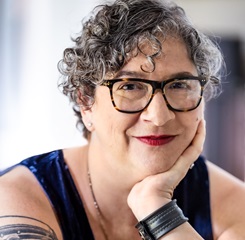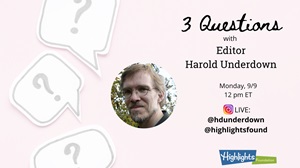Agent, author, editor and Highlights Foundation faculty member Linda Epstein joined Cat Galeano of the Highlights Foundation on Instagram Live to talk about Linda’s mini Show Don’t Tell: Making it Real with Sensory Details and Small Actions. Watch the conversation below. (Please note: closed captions are available in the video below. You can see them by hovering over the bottom of the video and choosing the “CC” icon.)
Some Takeaways
Linda says that when she talks to writers, she is sharing all the time about two things:
- Using sensory detail to ground your work without talking.
- Bringing the reader into the experience of what’s happening in the book by pulling them into the experience.
Of the oft-heard advice about the problem of “show, don’t tell,” she says: “I don’t think it’s a problem. I think it’s just something that we need to learn as writers, that we need to learn how to do. I think that there’s the words right “show, don’t tell” and you can kind of understand what it means. And then in my mini–and you know in my other work with Highlights and outside Highlights–I have longer courses, right, that kind of like go into that, like not only what it means, but how to do it. Those are two different things.”
At the mini, Linda says “I want to at least give people the preliminary tools to either look at the work that they’ve already created and see where there are places that they could show more and tell less. And I also want people to who are like in the midst of creating something to create with that in their head because it’s a different, it’s a different thing.”
Full Transcript:
Cat: Hi everyone, Welcome. Thanks so much for being here at this little lunchtime chat, please say hello. I have officially requested Linda, so I’m hoping she will join me any minute. I’ll send the invite once again. These things are always a little clunky in the beginning, so thank you so much for your patience. So exciting to see so many of you here. Thank you. All right. Technical difficulties. Thank you for your patience. It just sent to her again. Anyway, I would love for you guys to say hello in the chat. I see some familiar names, I see some new names, I see some friends.
Alright, let me send it one more time. Did it work? Yeah. It it’s a little clunky, but you know what? Once you get the hang of it, it works just nicely. You can hear me. I see you perfectly. We have quite a few friends already here, so that’s really exciting. Excellent.
I know for those of you who don’t know, Linda is a dear friend who I have started my writing career with, So I’m very, very honored, excited to be doing this with you. So yeah, I’m just going to get started. I am Cat Galeano, my pronouns are she/her, I am the social media manager for the Highlights Foundation, joining you from Westchester NY on the traditional and contemporary lands of the Siwanoy people. I am also a writer and a reader who is very excited for this live lunchtime chat with our friend and faculty, Linda Epstein about her upcoming mini course Show, Don’t Tell, Making it Real with Sensory Details and Small Actions.
Now, Linda, I have to tell you that I was personally thrilled to see this pop up on our course schedule because it’s a phrase that people have heard so much and is so important in the craft of writing for kids. But we know that you’re both an agent and an author. We also know that the feedback of “show don’t tell,” people get the feedback of “show don’t tell” on their drafts a lot. Does that phrase have a different meaning for you depending on which hat you’re wearing?
Linda: It has the same meaning. And before it, actually before I got my MFA, which is where Cat and I met each other, I tried to teach “show don’t tell.” I think it was at an SCBWI and I couldn’t do it because I couldn’t, didn’t know how to explain it. When I became–well, I was always a writer–But when I was studying writing I really learned–like I I got it in my head in a way that never left me. And I remember exactly when it was and who who taught it to me. It was Jill Santopolo, amazing writer, amazing editor, and she was my mentor for my thesis. And you know, we had to write this big long thing, which actually turned into Repairing the World, my middle grade book from Simon Schuster which came out in 2022. I had submitted something and it was a scene early in the book when two best friends who are the best friends in the book, Ruby and Daisy, are walking on this kind of like this tree has fallen down. They’re walking along the top. And I kind of had written something like, you know “they were walking across the tree and you know, Daisy lost her balance” and it was very, very TELL right? And Jill gave me feedback–And I can’t remember now if it was like verbal feedback or if she had like written. I think it was verbal feedback–and she talked to me about Daisy touching Ruby’s shoulders and feeling the soft cotton of her T-shirt as she was gaining her balance.
And all of a sudden it was kind of like everything I ever knew about writing–or thought I knew about writing–kind of like focused in and I was like, oh! So when I wrote my own book; one of the one of the things that people say about my book is that is that it uses a lot of sensory details, and it does. And I think I’ve taken that experience as a writer. I used that knowledge and I think I just like it exploded in my book. And then I kind of took that knowledge into my agent life. So when I get a manuscript to read, whether it’s as an agent, I’m also, I also do freelance editorial work and I’m a book coach. And when I talk to people, I find that I’m talking to people about that. All the time. Two things. Using sensory detail to ground your work without talking. Bringing the reader into the experience of what’s happening in the book by pulling them into the experience.
And there are parts where you you need to TELL stuff right where it’s like, not about like a physical thing. But when something’s happening, if your characters are talking to each other or performing an action, they’re not doing it like in front of a green screen. You know what I mean. Doing it like in an environment where this thing’s happening. And I talk to authors about it all the time, all the time, all the time. So as a writer. I really, it’s where I write. It’s literally where I write from. As a reader, it’s what I look for. And as an agent and an editor and a book coach, it’s really what I talk to to people about all the time. Sensory details and small actions, which is another thing.
Cat: I feel like we have to take the mini. Yeah. Basically this is just a small sampling. If you want to know more and ask Linda all the questions, please sign up for her class. This is sort of like a small sampling. But yeah, I do think it’s so important that this class that you created, this class, this mini that we’re sort of kicking off the new year with it. Because it is something that I feel like as writers we’re told so often, “show, don’t tell,” “show, don’t tell.” But it’s like, I don’t think we’ve stepped back to reassess what that word even and sometimes we’re so deep in our work that we’re like “show, don’t tell,” “show, don’t tell,” what does that even mean? I’m as a writer personally excited because I know I have that problem, I’m sure a couple of our friends here watching have that problem.
Linda: I don’t think it’s a problem. I think it’s just something that we need to learn as writers that we need to learn how to do. I think that there’s the words right “show, don’t tell” and you can kind of understand what it means. And then in my mini–and you know in my other work with Highlights and outside Highlights–I have longer courses, right, that kind of like go into that, like not only what it means, but how to do it. Those are two different things. Yes. And that’s what I was saying.
Cat: Like, I think we’re so used to like the meaning of it, but not necessarily like stepping into it and thinking about it in a way of like reteaching ourselves or perhaps perhaps looking at it with a different lens or whatever. That is just, yeah.
So I think we sort of answered the second question I had for you. I kind of want to, you’re so passionate about this topic and and teaching it so you mentioned to us before that understanding what “show don’t tell” means and then really making it happen are two different things. So basically what do you hope people take away from your mini?
Linda: I want people to have that same experience that I had with Jill, where they can see something in their own work and be like, oh! It’s what I want people to be able to get on the page what’s in their head or their hearts about in the story, onto the page, I hope peole–I mean, that’s like a big thing, right? You might not get that out of the mini, but I want to at least give people the preliminary tools to either look at the work that they’ve already created and see where there are places that they could show more and tell less. And I also want people to who are like in the midst of creating something to create with that in their head because it’s a different, it’s a different thing, yes.
Cat: And also like a mini course, the minis that we offer at Highlights are just a small sampling. And so like Linda mentioned, she teaches other courses for us, you know with us and she also has her services outside of Highlights completely. So I feel like this is a great opportunity if you’re thinking about it. If you’re nervous, the price point doesn’t hurt. So please, please come on in and sample away. My third question for you since this is a three question convo, is at what stage in the process do you tend to pay most attention to the aspects of your writing–plotting and outlining, drafting, early stage revising, later stage revising, some of the above, all of the above…
Linda: I’m kind of a I’m a hypocrite. Sorry. I’m a hypocrite because everyone says messy first draft and like, just get the story out, just put it down. I literally do not know how to write a messy first draft. Because I need to know where my character is. What are they doing? What’s happening around them in order to like, create the scene? So, for example, I’m in revisions now. I have an adult novel coming out in early 2025 with Allie Malenko and Liz Parker, and it’s called The Other March Sisters. Yes, it’s about THOSE March sisters. And we got our revisions back and turns out that they’re like, I need to write new scenes, right? And I’m like, oh my gosh, so I’ve been away from this manuscript for a while.The part of the story I’m telling is Amy March in Europe. So when I’m looking at what are these new scenes? Like, where is she? And I realized that where she is, I didn’t put in the first part.So I took a weekend to “bang it out…” It’s historical fiction, so I end up doing a lot of research while I’m writing so that I can know where my character is. Where am I going to set the scene? What are they doing? What’s happening? What was the weather in, you know, Heidelberg, at this time of year, I don’t know. So I feel like I personally am showing a lot when I’m writing and I think also I happen to write books that are not necessarily plot heavy. They’re very texture heavy so if you’re going to have like a lot of talking and thinking they have to be somewhere and be doing something. So it’s really important that that part’s interesting. Otherwise it’s just like talking heads and nothing’s happening and nobody wants to read that book.
So feel like I do a lot of that in the in my creation. In my thinking, you know my pre-writing and drafting probably not so much in revision because I’m a very slow writer and because I don’t follow the advice that I give to everyone, and everyone gives everyone about messy for stress, that there’s so much in there already that sometimes I have to dial it back a little bit. Like nobody cares about the all of this stuff you’re showing, you know? So she’s sweating and wiped her brow. No, it doesn’t impact anything. Oh, you know what I mean? Like that. So, umm. So I feel like for me, it’s a lot in the creation. Other people who are faster writers or know how to write a messy first draft might be able to, like, write their story, get it out, and then go back and be like, OK over here I said, you know, she walked into town. How am I going to show that? And how am I going to slow it down instead of saying she walked into town and was very angry. It’s like, well, that’s boring for you. And second of all, “she walked into town and was very angry,” that doesn’t pull your reader into the experience of a character walking and being angry. Whereas if you go on the walk with your character and you, you know, is it hot out? Is it cold out? Is it windy out? Is she on a busy street? Is she out on a, you know, is it, are there other people you know? How do we know she’s angry? Is she like, are her fists clenched, is she clenching her jaw? You know, she like, got an expression on her face–that’s all showing. So someone else who wasn’t me could go back and do that, and then it would be a revision process. There’s no right way to, there’s no right way to write. there really isn’t.
Cat: I for one will definitely be taking your course because I know I need to learn exactly what we’re talking about, I need to learn to to show and not tell, because for those of you that may not know, I used to be a journalist and I used to write for TV. So I’ve had a long existing issue of trying to fluff something up a little bit more instead of what Linda just gave the example of “I walked into the store angry” because that’s really what I had to write before. So my learning curve has been kind of learning to, to show more.
Linda: And it’s interesting because I’ve noticed that people who come from a screenwriting background or a journalism background somtimes even picture books, they don’t need to do that. Like writing a picture book. You don’t need to “show, don’t tell,” because the pictures are going to show right? And you know, like when you’re writing a screenplay, you know, like you’re writing, I don’t know how to write a screenplay, but I, you know, like she walked in angry and it’s like the actor is angry, you know, and you just have to deal with like the dialogue and the action.
Cat: So I think that’s actually such an important thing that you’re saying because with like journalism, screen writing, picture book, like the language is so tight. You don’t have room to do anything else but say the thing. So I feel like this course is would be amazing for anyone who’s either pivoting or wanting to explore, or just simply need to learn a little bit more how to extrapolate all those words that they have in their head and they’re literally just writing, “walked into the store angry.”
Linda: That’s kind of why when you say, you know, I have that problem, It’s like, I really don’t think it’s a problem. I think it’s just another thing that we need to learn. It’s like if you want to write poetry, you would need to, like, learn how to do some of those things, you know?
Cat: Oh, I am so excited. Literally already signed up for January 9. So those of you that haven’t, please do so.
Linda: I am really excited to teach this course.
Cat: Is there anything else you wanted to let our Highlights family knkow, or anyone interested? Because my three questions are finished so I just wanted to pass it over to you.
Linda: I don’t, you know…like buy my middle grade book Repairing the World. I have a self published poetry book called Re:, which is poetry for adults. And you can buy that on my author website. I think there’s a link there. My author website is https://lindaepsteinauthor.com/. And yeah, and just I think that’s, you know, like buy my books, you know, when there’s an opportunity to pre-order The Other March Sisters do that too.
Oh, I know what I want everyone to know. So it’s the end of the year and I want everyone to know how much I value Highlights, the HighlightsFoundation and the people who work for the Highlights Foundation because participating in teaching with Highlights has really helped me grow as, you know, an author and an agent and a human being being part of the Highlights family is areally important part of my life so I just want to share that I want to thank you. Family is a really important part of my life, so I just, I want to share that. I want to thank you know, you and all. For that, I met some of my closest, some of my closest friends ever at Highlights.
Cat: We love you, Linda. Thank you so much for that. I just have my little outro that I’m going to give and then we’re going to wrap it up. But if you’d like to learn more from Linda, like she said, you can visit her website, https://lindaepsteinauthor.com/ or you can register for her two night mini “Show, Don’t Tell: Making it Real with Sensory Details and Small Actions taking place January 9th and 11th at 7:00 PM Eastern. So right after the new year things are going to calm down a little bit and then we’re kicking off 2024. So we hope to see you after the close of the course. So let’s say those two dates are not good for you. Please sign up anyway. You will have availability to watch the recordings for a month, so that way you can watch as many times as you want, take as many notes as you want, even if you’re not interacting with us live. Her books are also available to purchase on our virtual book shop powered by bookshop.org. And thank you Linda for joining us today and we can’t wait to see you online again all the time with us. Thank you everyone for joining us! Bye!







